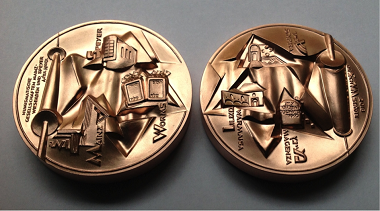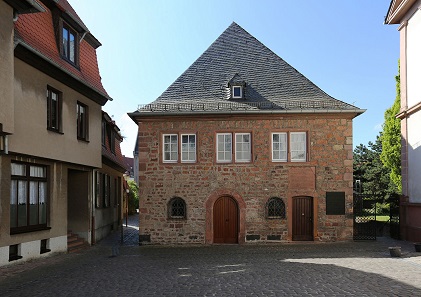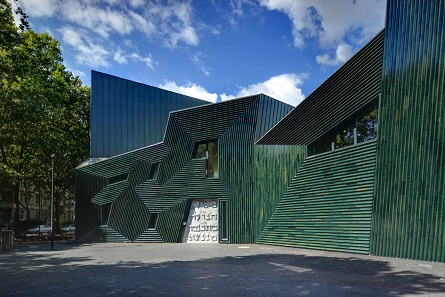February 21, 2019 – The Numismatic Societies of Mainz-Wiesbaden and Speyer have issued a medal to commemorate the mediaeval Jewish ShUM communities of Speyer, Worms and Mainz and to promote the cultivation of their heritage. The medal was designed and struck by Victor Huster of Baden-Baden.
The copper medal weighs 215 g, is 59 mm in diameter and is issued at a mintage of 60 pieces.
Jewish communities have been documented in the three Rhenish cities since the 10th and 11th centuries. In the 12th century, they formed an association called ShUM (acronym of the Yiddish names Shpira, Warmaisa, Magenza), which issued regulations and statutes in religious, legal and cultural questions (“Takkanot ShUM”) for the whole Ashkenazi world. Prominent rabbis made colleges (yeshivot) in these cities into centres of Jewish scholarship. In spite of the continual persecutions and expulsions during the Crusades and the Black Death, the ShUM communities remained in existence until the middle of the 15th century. Subsequent expulsions and emigration led to their extinction.
A 2014 picture of the repeatedly rebuilt Worms Synagogue. Photo: Willy Horsch / CC BY-SA 4.0.
The obverse of the medal displays a Torah scroll being opened and rolled back (on the right) with a Star of David on wavy parchment symbolizing the many discontinuities in history. Important mediaeval sites of remembrance of the ShUM cities (names in Ivrit and Yiddish) are depicted. In Speyer, these are the remains of the old synagogue and the mikvah (ritual bath) dating from the beginning of the 12th century, Worms is represented by the old synagogue of 1174, which after its destruction in the Nazi years was reopened as a reconstruction in 1961. The tombstones on “Judensand” are the remains of the mediaeval Jewish community in Mainz. One of its most famous representatives is the Talmud scholar Gershom ben Yehuda (ca.940-1028 or 1040), who to this day is revered as the “Light of the Diaspora” (“Meor ha-Gola”). His mediaeval memorial stone reproduced on the medal stands for the many other Jewish scholars of the three cities.
Architect Manuel Herz designed the New Synagogue of Mainz. Photo: Manuel Herz Architects / CC BY-SA 3.0.
The reverse of the medal (end of scroll on the left) addresses Jewish life in the three cities at the present, with their Jewish landmarks occupying the same positions as those on the obverse. Speyer and Mainz are represented by their new synagogues of 2011 and 2010 respectively. The new Mainz synagogue designed by the architect Manuel Herz with its expressive façade of letters designating “Kedushah” (holiness) is especially striking. At its entrance it bears the name “Light of the Diaspora”, thus connecting it with the mediaeval community. The old Jewish cemetery in Worms (“Heiliger Sand”) remains to this day a much-visited site of remembrance. The tombstones of Rabbi Meir Maharam ben Baruch Rothenburg (left) and of the merchant Alexander ben Shlomo Wimpfen (right) of 1307 continue to be revered by present-day pious visitors, as attested by the “Kwitlekh” (intercession prayer notes). The German names of the three cities, the names of the issuing numismatic societies and the signature of the medal artist complete the messages on the medal.
It is the wish of the issuing numismatic societies and of the medal artist that the application of the three cities to have the heritage of the ShUM communities included in the UNESCO list of World Heritage Sites may be successful. The application was presented as early as 2012.
The medal can be ordered from Dr. Wolfgang Dreher (Speyer) or Dr. Karl Ortseifen (Mainz).
More information about the work of the Numismatic Societies of Mainz-Wiesbaden and Speyer is available online.
To learn more about these Jewish communities, please visit the website of the ShUM-Cities Speyer, Worms, Mainz e.V.
This short film tells you more about the history of the ShUM communities and the effort to have them added to list of UNESCO World Heritage Sites.







